Akafuku Mochi: Ise’s Iconic Sweet for Pilgrims
Aug 04,2022
Akafuku Mochi: Ise’s Iconic Sweet for Pilgrims
Aug 04,2022
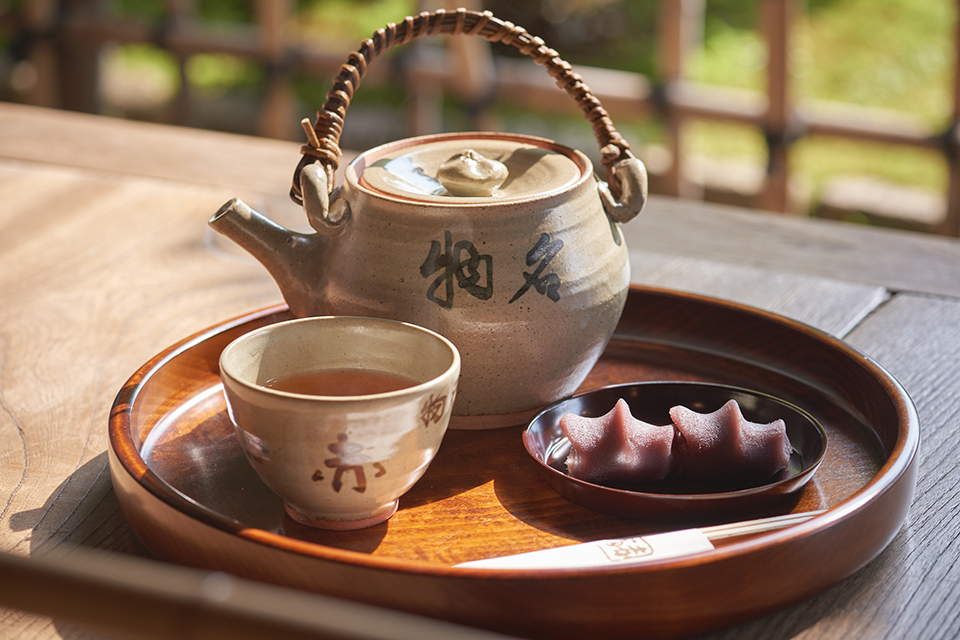

Many people consider akafuku mochi, a rice cake sweet, to be the Mie prefecture souvenir. At Akafuku Honten, a venerable Japanese confectioner that sells akafuku mochi, the water is already boiling in the kamado ovens to make coarse bancha green tea and the steam is starting to rise at 5 a.m., as the town slowly begins to wake.
The store opens just before visits to the Ise Jingu shrine begin, both welcoming visitors and seeing them off with a spirit of hospitality that has been handed down for over 300 years since the store was founded. For this article, we visited Akafuku Honten, which is built with a gabled roof in the traditional Ise architectural style.
Akafuku mochi, a famous Ise rice cake sweet, is known far and wide for its soft mochi rice cake completely covered in smooth red bean paste. The staff at Akafuku Honten light the kamado ovens and start boiling water at 4 a.m. in order to be ready to open the store at 5 a.m. when visits to Ise Jingu begin.

Ishida Manami, PR manager for Akafuku Co., Ltd., explains. “Visitors can enter Ise Jingu from 5 a.m. year-round. Since we are so close to the shrine and depend on it for our trade, we strive to always have the store open by 5 a.m.”
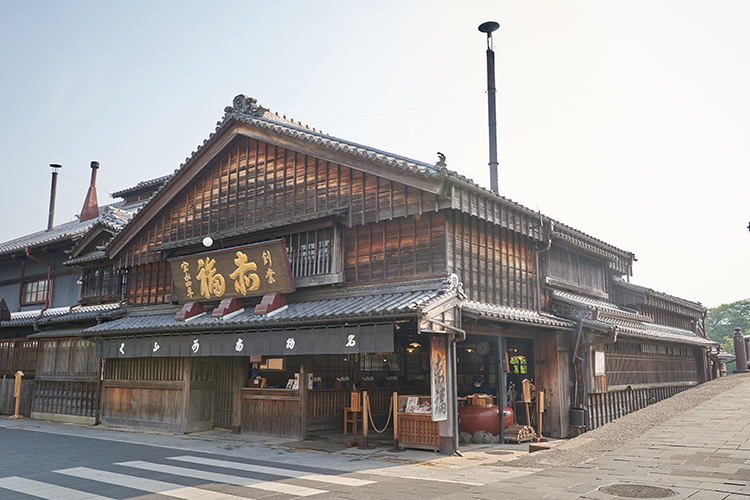
Located in the middle of Oharaimachi, the district in front of Ise Jingu, Akafuku Honten welcomes visitors to the shrine to this day with the same heartfelt hospitality since the Edo period (1603 to 1868), when visiting Ise Jingu was a once-in-a-lifetime dream for commoners.
Visitor numbers to Oharaimachi plummeted from the start of the Meiji period (1868 to 1912), with the rise of motorization. To revive the area, Akafuku tore down its head office building on a corner of the district and recreated the old Ise townscape using the traditional architectural style of Ise.
Akafuku recreated the townscape as it would have appeared through the Edo and Meiji periods while being meticulous about having it be as authentic as possible, to distinguish the project from amusement parks that only imitate the real thing. To do this, the company made use of locally procured timber and the traditional building techniques of temple carpenters as well as brought together various kinds of traditional food and souvenirs sold along the Iseji pilgrimage route. The district was named Okage Yokocho and has become a major tourist attraction for visitors to the shrine. It has also become a symbol of how to successfully revive a district around a famous shrine.
Behind and to the right of Akafuku Honten’s noren curtains under the building’s large Akafuku sign stands three vermilion-colored kamado ovens in a row. The vivid vermilion color is carefully maintained by restoring and polishing the ovens at the end of each year.
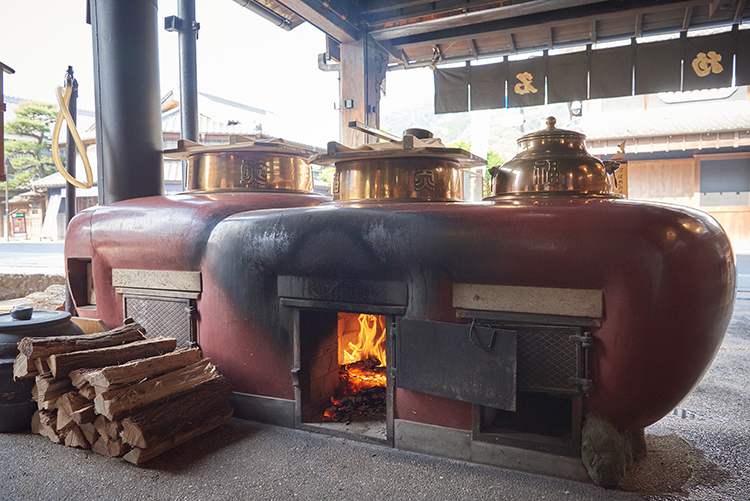
The main item on the menu is the akafuku mochi tray. Two pieces of akafuku mochi on a plate and a pot of fragrant bancha tea brewed with hot water from the kamado arrive on a round wooden tray.
The souvenir akafuku mochi that come in a thin wooden box are delicious in their own right, but nothing tops having freshly made, exquisite akafuku mochi on the engawa porch or in the tatami room overlooking the Isuzu River. The red bean paste and mochi rice cake complement each other perfectly. The two akafuku mochi pieces melt in your mouth and slip into your stomach in no time.
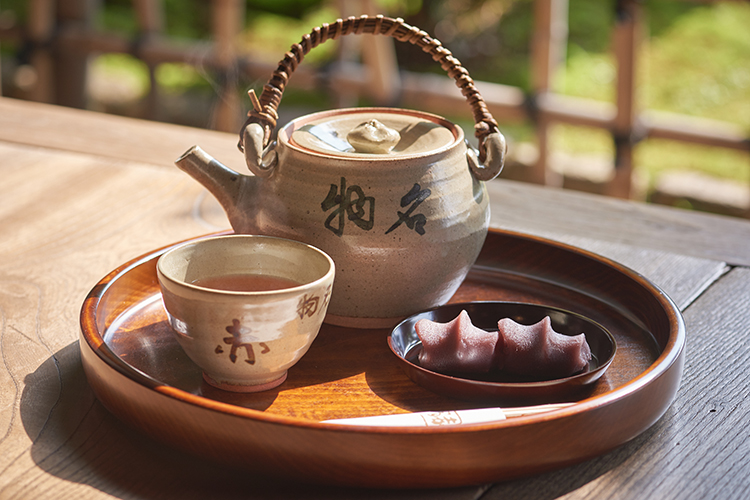
“The shape of akafuku mochi is modeled after the murmuring Isuzu River. The three ripples in the red bean paste represent the clear-flowing river, and the mochi represent pebbles on the riverbed. The akafuku mochi we sell are all handmade one by one by mochi-ire-san, the name we call our confectioners.
“It takes at least three years of training to be able to quickly form the three ripples perfectly each time — something we call three years of mochi-ire. Trainees start by practicing over and over again with rice koji bran, which has a similar feel to the bean paste. Once they are proficient with that, they move to the next step where they finally practice using red bean paste. Even after becoming a full-fledged mochi-ire, our confectioners continue to hone their skills at in-house skills competitions.”
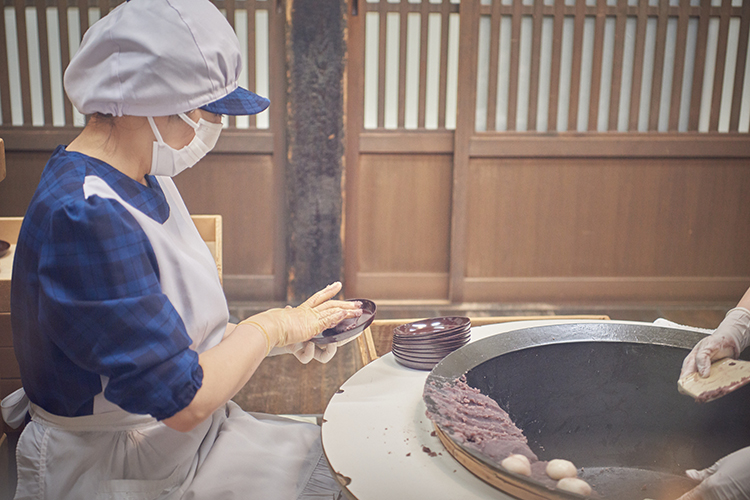
You can watch the mochi-ire-san confectioners at work through a glass window at Akafuku Honten.
They work facing in pairs, with one person pulling out and rolling the rice cake into firm balls and the other covering the rice cake with the red bean paste and forming the three ripples with their fingers. The ability to repeat these movements precisely every time is the mark of a true artisan. Watching the mochi-ire-san, in their adorable, old-fashioned uniforms, silently making akafuku mochi in a wooden-planked workspace gives one an unusual feeling of nostalgia.
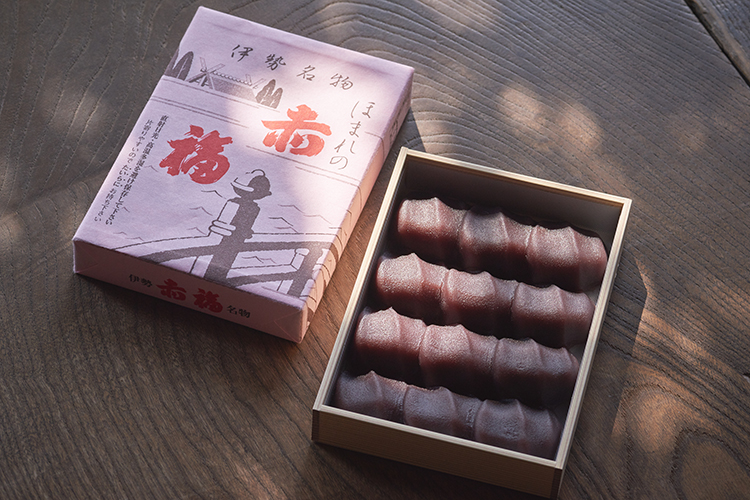
Besides the standard akafuku mochi, another hugely popular offering at the store is tsuitachi mochi [mochi for the first day of the month]. There is a custom in Ise called tsuitachi mairi where people rise early and visit Ise Jingu on the first day of the new month to give thanks for getting through the previous month safely. In keeping with this custom, Akafuku Honten starts offering tsuitachi mochi from 4:45 a.m. for tsuitachi mairi visitors on the first day of every month apart from January 1.
“Many customers come to our store to enjoy our monthly specials that incorporate a sense of the season or local customs. For example, in July we offer take-nagashi, in which soft red bean jelly made with the red bean paste for akafuku mochi is poured into young bamboo. And for August, we offer hassaku-awamochi in keeping with the custom of eating awamochi [millet rice cake] to pray for a plentiful harvest on the first day of the eighth month on the old lunar calendar. Because of the popularity of these items, we hand out numbered tickets with specified pickup times from 5 p.m. the day before to minimize waiting times.”
During the COVID-19 pandemic, Akafuku Honten began selling a new product — white and brown mochi — with the hope of lifting people’s moods during the dark times. Each package includes four pieces each of brown-sugar-flavored brown mochi, which were produced from the Hoei period (1704 to 1711) to the Meiji period, and white mochi covered in white-colored bean paste, which the company produced in the Heisei period (1989 to 2019) and into the current Reiwa period. Sales were initially exclusive to the company’s online store, but now that the supply has stabilized, the product is available at the company’s direct outlets as well. The number of packages sold each day is limited, so be sure to visit the shop early to avoid disappointment.
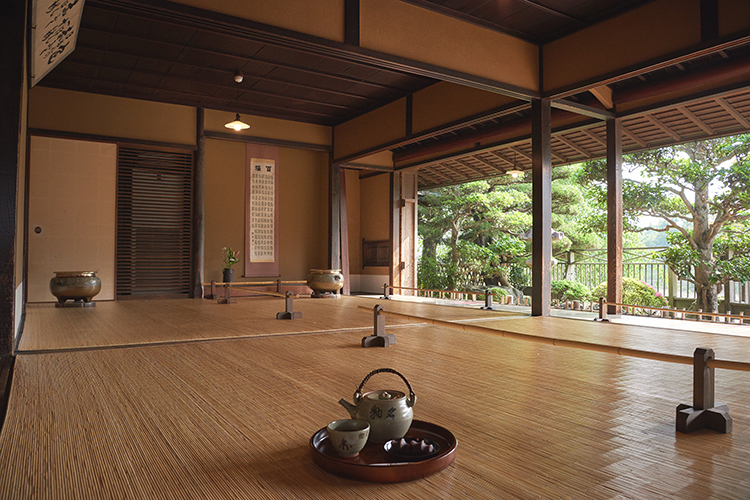
Akafuku continues to create new products grounded on the traditions carried on throughout the changing times from the Edo period to the present Reiwa period. Only at Akafuku Honten can you enjoy Japanese confectioneries while watching the brisk movements of the workers, listening to the murmuring of the Isuzu River that brings a cool breeze, and contemplating the passage of time.
Akafuku takes its name from the expression sekishin keifuku, which says that if you rejoice in the happiness of others with an accepting heart like that of a newborn, happiness will make its way back to you. The store continues to symbolize the happiness of visitors to Ise Jingu.
